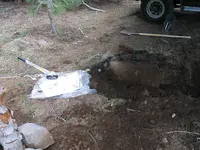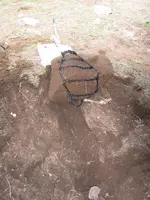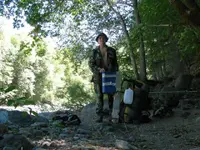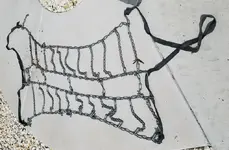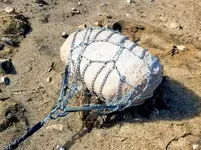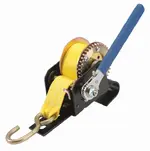Hi There Tahoegold,
Yes, anything is better than hands only and that is everyone’s starting point, hands only. The next step is leverage, I carry a ~ 14” Eastwing Gad Prybar and it is amazing what one can do with that tool! It is limited to what can be done with it though it is small enough to protect the user, that is, a person can literally only do so much with it. I would not even consider a 3’ lever and I’ve damaged myself with a 4’ lever so I’d have to say a 6’ lever bar would be the ultimate however, that unit is really a heavy Awkward tool to carry down a mountain and most likely it would stay down there forever.
Oh yes, where I go is way out back of the back country, way down a mountain side so getting in and out is always serious business and being in shape, wearing a Backpack that fits and handles heavy loads, having good supportive socks and boots, being in top physical condition and using a hiking staff (the two hiking poles are not strong enough IMHO) are all so important to make the trip as safe as possible and to be able to get out after one has gotten in. Some parts of the trail’s I take are very narrow with sizeable drop-offs though even a 4’ drop with a heavy pack is going to “damage a person”! I’ve hiked out with an 85 lb pack ON a Broken Leg with a badly sprained ankle (same leg) and take my word on it, that was no fun! Having some heavy duty pain killers in my first aid kit was meant for times like that! If a person can not take care of themselves out there then stay home. I also carry a SPOT Messenger, it has saved my life once so I always carry it!!!!!!
Next is mechanical means like leverage from the mechanical advantage of a pulley system which you use. The pulley system is only useful IF one can hold onto the boulder being moved. Holding onto the boulder requires at least two things physical contact by wrapping around the boulder and staying in place as the boulder moves/rolls/teeters etc. Truckers Straps are more adjustable to the size of the boulder than tire chains, Reed’s boulder net has a lot going for it as it is quite adjustable while tire chains are limited in size though Ratled’s linking a set together along their width makes a lot of sense. Steel chains are heavy, anything made from steel is heavy but steel does not shred like pull straps will. I was way up a mountain working in a stream bed moving boulders with a strap (not a trucker size strap) and as the boulder moved, it lay right over on that strap and cut half way through the fabric, I was not pleased. That’s when I switched to tire chains. (the components for Reed's boulder net are expensive but it becomes a Class outfit when completed. The swagging tool that I've seen is over a $100 dollars then the cost of the swages and the cable and stuff) Then again why are we doing this - to make it easier/safer to find gold.
On that shredded strap adventure I was using a 2000 lb rated Harbor Freight cable hoist and the darn thing just fell apart, all sorts of parts bent and failed. I then purchased the 8,000 lb capacity unit and have been a happy camper ever since. I also purchased a length of ~1/4” cable with slip & grab hooks on it. The cable is cumbersome and one must be carful to not kink the cable but it works. The attachment to the hoist is accomplished with a 4’ length of chain as IF the cable snaps the chain just drops which can help to stop the cable from whipping around and slapping a person up side of the head. Again, when using any tree as an anchor point, protect the tree from being damaged with carpet, burlap or sticks. Snatch blocks are a cool add on for hoist/winch efforts, I bought mine at Tractor Supply store. They allow one to change a pull angle, like one can turn corners with a snatch block. Oh they are heavy. (Either cable hoist is only good for short pulls then you need to hold the load, unhook the hoist and shorten the length of the fixed cable, reset the hoist and go again)
I’ve a duffle bag I keep my hoisting gear in and the whole thing weighs about 85 lbs. I strap it to a bare packframe (the bears Shredded the pack bag) and away I go with it though this means a trip back up and down the mountain. Once I hauled my 2’ sluice unit, wet suit, gasoline and the “whole catastrophe” (Fiddler on the Roof) along with all my camping equipment around in the Sierras, took three trips in and three trips out. A lot of that hauling was without trails so I was cutting trail while hauling. I was younger and stronger then and possibly a lot less knowledgeable (smarter) though I’m not much better about those things now!
It would be nice to have feather weight equipment to bring along but then what use would it be. What we do out there is Work and at times darned hard work. The equipment we count on to get the job done must be reliable as the boulder alone is heavy and when one adds the extra pull needed to move the rocks that are holding the boulder in place, it just takes a lot of energy to do the job without hurting the self. Being able to drive up somewhat close to “the Job Site” is nice but how often does one have that option? (lucky dog)
Tahoe, where did you purchase your strap winch from?
It amounts to a choice in equipment and techniques which is what you asked about Tahoegold and these are just my thoughts and I hope they help………….63bkpkr
{Note: a metal detector can also be used to locate a spot on the shore that has no signal. A bucket of gravel can be dumped on the spot, the metal detector is used to check for a signal, if no signal there is no need to work that gravel. Test to confirm my statement! but I've done this and it does work}
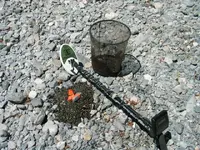
Of course if one has a GGT with them, heck throw it all in there!!!!!! Oh wait, that's even more stuff to haul in and more trips to make, man I'm gonna be tired the first three days of the next trip.




